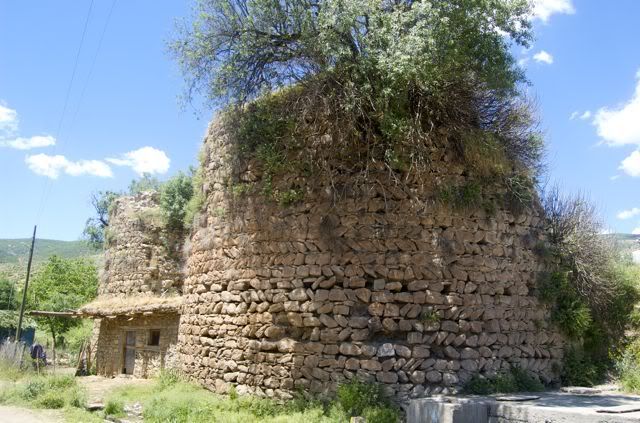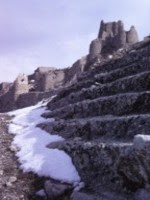 A sign of reality?
A sign of reality?This isn't a good time for an American to evaluate the politics of another country. We sit here with all our faults exposed: lunatic "tea-baggers" on parade; our economy trillions in debt; our politicians determined to prove their spinelessness or their stupidity, or both. But in Turkey, what a year 2009 has been: a year of hope and despair; of war and cease-fire; of initiative and inertia. It began in the spring with a political campaign, and democracy's most common ploy: an attempt to buy votes. The election: a nationwide poll for local officials. Across the southeast, and especially in the province of Dersim (Tunceli), Turkey's ruling AK Party called up their bankers, loaded up the trucks, and started delivering prizes to local voters. There is a great tradition of this sort of thing in western democracies. In England it used to be free ale. In 19th century America, it was free whiskey and cider. More recently, among big-city political machines, hams or turkeys went out by the thousands. In the southeast this spring it was refrigerators.
For the AKP, however, it didn't work out. The Kurds took the refrigerators from the AKP and voted for the other party, the DTP, or Democratic Society Party, which won big victories in local elections across the Kurdish southeast. The Turkish state responded in the usual way: they started arresting officials of the DTP. The charge: "supporting terrorism." This is what all DTP members are accused of: they won't denounce the PKK and its guerrillas as a "terrorist" organization; therefore, they are "supporting terrorism." Never mind that the PKK is a bunch of armed people organized in military units, dressed in uniforms, attacking another bunch of armed people in military units and also dressed in uniforms. The Turks insist that this makes them "terrorists." Never mind that the civilian politicians of the DTP all know families who have lost a child fighting in this war, or know people who have been driven out of their villages by the Turkish Army, or know people who are either in the PKK or have been involved with them: they must, in spite of this, denounce practically everyone they know as a "terrorist."
By May, Barack Obama had come and gone, repeating the usual State Department-Pentagon boilerplate about Turkey's "vibrant democracy" and fight against "terrorism." Abdullah Gul, President of Turkey, declared in May that, “Whether you call it a terror problem, a southeastern Anatolia problem or a Kurdish problem, this is the first question for Turkey. It has to be solved.” The AKP government, backed by business interests and hungry for its pending EU application to be approved, began to make noises about sincerely wishing to improve the lives of its Kurdish citizens, openly admitting that things had to change. In June, however, appearing at a news conference in Washington, D.C., the Turkish Armed Forces Chief of Staff stated quite plainly that his forces had no intention of making peace, and would fight on until the last terrorist was killed.
Nevertheless, by July and August, Prime Minister Erdogan and his associates seemed bent upon doing the impossible: bringing democracy to Turkey. They were calling their program, still undefined, as the "Kurdish opening." More Kurdish broadcasting hours; the restoration of Kurdish names for villages and towns; endless optimistic discussions in the news media: everything, it seemed, was going the right way, and with the PKK abiding by a unilateral cease-fire, the war seemed abated.
Except it wasn't. Low-grade conflicts continued, and the Turkish Army never stopped shelling across the border toward PKK positions in northern Iraq. Human rights monitors reported the same patterns of harassment and abuse among the populace. By the end of August the nationalist opposition was speaking out, saying that the nation was "one" and always would be, and Gen. Ilker Basbug, the Chief of General Staff, repeated that he had no intention of making peace with anyone.
In October, joy erupted. At the directive of Abdullah Ocalan, the imprisoned PKK leader, a group of PKK fighters came down from the mountains and crossed through the Khabur border gate between Iraq and Turkey. Turkish officials allowed them entry and did not arrest them, and they proceeded through Cizre and on to Diyarbakir. What followed were surely the most extraordinary days in the history of Turkey's Kurds. Masses of people flooded the roads and streets in the PKK group's path, waving banners and shouting with happiness. Peace truly seemed possible.
But this was Turkey, and nationalist Turks were offended. The celebration was "unseemly." The Army, nationalist politicians, and parents of dead Turkish soldiers did not approve. The Democratic Society Party (DTP) was accused of orchestrating the spectacle. Which of course they did. And why shouldn't they? This was the first time in thirty years that young PKK fighters had come back to their families in anything but coffins. How could the Kurds of the southeast NOT celebrate this occasion? They would have to be made of stone not to feel the importance of these events. Anyone who goes to the website of Firat (Euphrates) News,
http://firatnews.com, and enters into its Search (Arama) window the word "taziye," can see why. There they are, hits by the hundreds. Taziye means "condolence," and it refers to the "condolence tents" which are erected for grieving families to receive visitors after (a) their son or daughter has been killed fighting with the PKK, (b) their child has been killed by a mine or a stray mortar shell, or (c) their husband or child has been found murdered. At Firat News page after page of "taziye" hits roll by, and anyone with the decency to look will see why the Kurds of Turkey's southeast would feel justified in displaying their happiness at seeing their children come back alive.
But it was the opening needed by Turkish nationalists. For years they had been waiting for first the AKP, and then the DTP, to be closed by the Constitutional Court. In 2008 the AKP had barely escaped closure, and after their reprieve the Erdogan government had a chance to change the laws that have made Turkey, in the common phrase, "a graveyard of political parties." Not only did they not do so, they did not try. In the aftermath of the PKK return celebrations, the court went ahead with the case against the DTP.
In the meantime, in the absence of any sign of peaceful intent from the Turkish Army, and after losing a score of their guerrillas to air, artillery, and ground attacks from the Turks, the PKK officially abandoned their cease-fire. Still, they did not pursue an active campaign of aggressive attacks. That ended in early December, when a group of PKK fighters, acting on their own initiative, ambushed a Turkish patrol in the province of Tokat in central Anatolia, alarmingly close to Ankara. Nationalist anger erupted, and within days the results came down in the case against the DTP.
The conclusion was foregone. The DTP was closed, and its leaders were barred from participating in politics for five years. All twenty of the DTP's members in Parliament resigned their posts in protest. And the cities of the southeast have exploded in what one Kurdish newspaper called "waves and waves" of riots, protests, and violence.
But it's a humble shepherd who I find, thanks to a friend, is the quintessence of all this absurdity. Abdullah Isnac (is-notch) must be the lowest-ranking municipal employee ever to get in trouble for a political demonstration. The
Taraf newspaper uses the word "coban" to describe him, a word which in English, at least, has rather positive connotations. Really, it means that he looks after animals. In this case, it is stray cows that have wandered away from their owners and are blocking the streets of Sirnak, that town behind the Cudi mountain whose name means "Noah City" (shehr-nakh), after the landing-place of the Ark. In the indictment of the DTP, he is identified as a "politican" and is barred from politics for five years. So perhaps this is the way 2009 ends for Turkey, with the story of a poor shepherd, the lowliest of city employees in the southeastern town of Sirnak, a man whose job it is to round up stray cows from the city streets and return them to their owners, a man who despite his insignificance is mentioned by name in the most important judicial decision of the year and forced to "keep out of politics" for the next five years. Thus has history repeated itself, and ended again in farce.
Has Turkey totally regressed on the Kurdish question? No one can say that. The AK government says that they will stick by their program, and maybe they will. The Kurds most definitely are not going back to where they were. Near Diyarbakir, road signs (see above) point to villages whose Kurdish names are reborn. In the same city, a little girl has opened a home school to teach her classmates how to read and write Kurdish. In the Turkish parliament, a Kurdish politician has risen to describe, in candid terms, the genocide of 1915 against the Armenians. Despite police repression, people have long since ceased to be afraid of expressing their opinions or their identity. In the mountains, the PKK claims that 800 new recruits have graduated from their training camps in the past nine months. In Turkey, no one is backing off.
Labels: Cudi Dagh, Kurds, PKK, Turkey



















